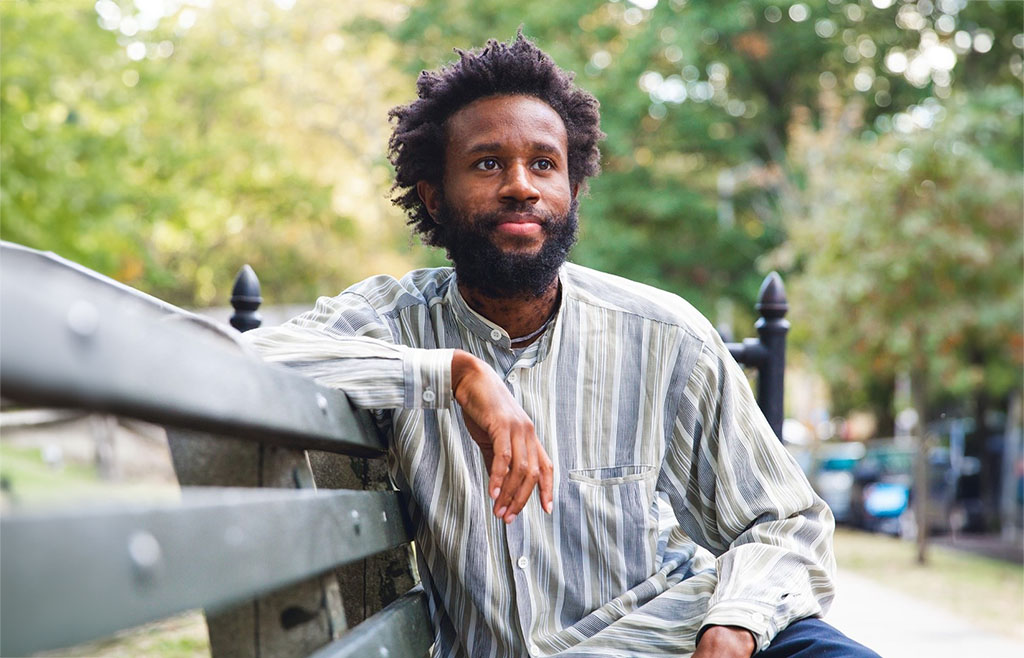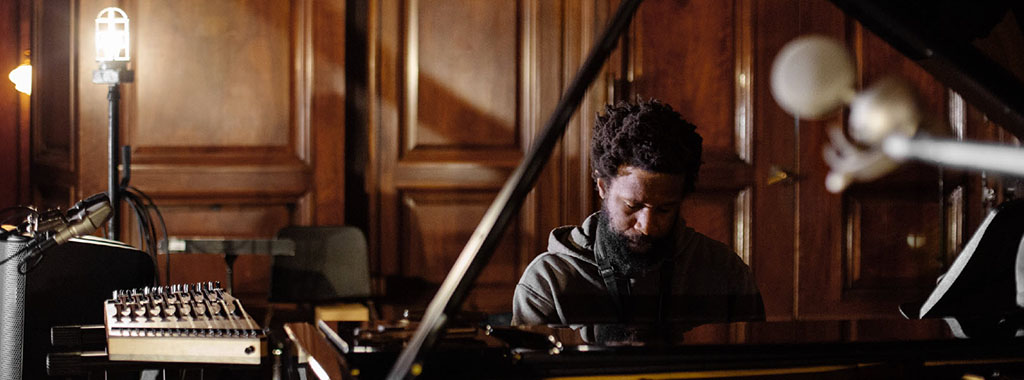JJJJJerome Ellis is a profoundly innovative artist whose unique voice as a self-described stuttering, Afro-Caribbean composer, poet, and performer resonates through his compelling interdisciplinary works. His projects invite audiences into experiences of healing, transcendence, and communion, emphasizing the intricate interplay of speech, silence, disability, and spirituality. Throughout his career, Ellis has collaborated with a diverse range of artists and institutions, including choreographers, rappers, and prestigious venues like the Metropolitan Museum of Art and Lincoln Center. His latest transdisciplinary endeavor, Aster of Ceremonies, explores historical narratives through music and storytelling, focusing on 18th and 19th-century Black runaway slaves who stuttered. Ahead of his performance at Smith Memorial Hall on Wednesday, April 17th, I spoke to Ellis to learn more about his process and latest project.
JJJJJerome Ellis’s performance of Aster of Ceremonies promises to be a powerful exploration of history through music and voice, blending the echoes of the past with the technology of today. For those interested in experiencing this unique lecture performance, it will be available both in-person at Smith Memorial Hall and via a virtual Zoom session (register here). To ensure accessibility, ASL interpretation and CART captioning will be provided, along with verbal descriptions of on-stage activities. Copies of the Aster of Ceremonies book will also be available for purchase at the event, allowing attendees to delve deeper into the themes explored during the performance.
In-person attendees are encouraged to wear masks and avoid strong scents to ensure a comfortable experience for everyone. Free masks will be provided, and the venue, equipped with automatic doors for accessible entry, is located on the southeast corner of Smith Memorial Hall. To join virtually, please register in advance at this link. This event is a unique opportunity to engage with Ellis’s work and witness the interplay of history, art, and community in a dynamic setting.
This interview has been edited for length and clarity.
Smile Politely: In your work, you talk a lot about time. Can you expand on how your creative practice has been influenced by the idea of time, or timekeeping?
Jerome Ellis: I think one thing for me is that in my work I am trying to imagine how it might feel, to feel like I have the time that I need. Because often, as I think many people feel, I don’t feel like I have the time that I need or enough time or I feel that time is inaccessible in one way or another. I’m thinking in this moment of the musicologist Susan McClary. I’ve learned a lot from her writings about what she calls, “music’s temp work:” the way that music and musicians do work in helping us navigate time. So I want to thank her for her work.
SP: Similarly, can you talk about how you utilize silence in your work, and why that can be significant?
Ellis: I think for me, one of the ways that I am interested in using silence in my work is through my experience of my stutter, which often opens up an interval of silence. The stutter opens up to what I sometimes refer to as, as the clearing. That silence is the clearing. It opens me up to certain vulnerabilities, and different people in different situations react to that silence in different ways. Sometimes people wait and listen. I feel that I am the other person or the group of people who I’m talking to, we enter into an intimate, shared experience of that silence. Other times people will and have, mocked me or made fun of me. That’s another side of the vulnerability that that silence opens up. I’m interested in the ways that that silence disrupts certain norms around time and speech communication. I’m interested in that disruption and what other possibilities might arise when something is disrupted. I think I learned a lot from the ways that different protests use disruption and interruption. Like the way that a protest will sometimes interrupt traffic in order to do that. [They will] interrupt traffic as part of the action that that protest is engaging in.
SP: What is most exciting about doing interdisciplinary work, specifically your video work? What’s different about that creative process, if anything?
Ellis: I think video excites me because I’m grateful for the way that video allows me to combine image, music, and text; that it allows me to express certain things that I would have to express in a different way if I were writing a poem or writing a song. I like video because I feel video can really help me connect to a place. There’s a video that I made largely in the Bighorn Mountains in Wyoming and at the Ucross Residency in Wyoming. Using the camera really helped me connect with the land and the place in specific ways. That’s something I’ve learned a lot about from artist Teju Cole. He’s written about how photography can help us connect to places.
SP: In Aster of Ceremonies, you use piano, saxophone, electronics, and voice to create a unique soundscape. How do these different elements interact within the performance to convey the stories of Black runaway slaves who stuttered?
Ellis: One thing I’m particularly interested in, when using different instruments, is to create a space where I can pose certain questions and explore the practice of ancestry. For me, the essence of being of Aster of Ceremonies involves engaging with the legacy of these Black runaway slaves. By practicing ancestry, I mean that I view these ancestors as my spiritual forebearers, not necessarily blood relatives. Beyond that, I feel a connection of spiritual ancestry with them. As a Black person who stutters, I feel a connection to them, and I desire to feel a connection to them. So, part of the practice of ancestry is trying to be in some kind of relation with them. I find one of the ways that I want to practice that is with music. And the music is a space of a kind of unknowing and uncertainty; uncertainty about the possibility of me connecting with these ancestors. The music creates a space where I can practice being in relation.

SP: The Aster of Ceremonies book available at the event suggests a tangible extension of the performance. How does this book complement the live experience, and what additional layers does it add to the overall narrative you’re presenting?
Ellis: Yeah, I think the book being available at the event helps. It’s like telling the audience “If you want to go further into this work, here’s your chance — you can dive deeper.” In the performance, I only share just a fraction of the book’s text. And there’s also an audiobook that audience members can explore further if they want to. I like the book as a kind of different approach to this material. While the performance leans more toward music, the book emphasizes the printed word. I’m interested in exploring what each medium has to offer.
SP: Collaboration seems to be a significant aspect of your creative process. Can you share an instance where collaboration profoundly impacted your work?
Ellis: Well, I just had an amazing collaboration this week at Beloit College. There’s an ensemble there called Multi that is directed by the amazing musician and educator, Cullyn Murphy. I had the great privilege of working with this student ensemble. We created an improvisational piece together that we performed for the community there. It was just a dream for me to be able to work with this brilliant group of students, and I learned so much from them. So I want to extend my thanks to them.
SP: As someone who explores what stuttering can teach us about justice, what insights or messages do you hope audiences take away from your performances?
Ellis: I’m interested in gathering with other people to think about stuttering and injustice together, and I don’t have answers to that and that’s why I want to get with other people and learn together and study it.
JJJJJerome Ellis’s Aster of Ceremonies
Smith Memorial Hall
805 S Mathews Ave
Urbana
W April 17th, 7:30 p.m.
Free (or register to attend virtually)








